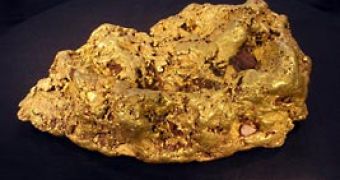Golden nuggets triggered various gold rushes in the last two centuries, from California and Alaska to South Africa and Australia. The endeavor of thousands of people resulted in gold used for making jewels: from the necklaces of the rappers with bad taste to the most sophisticated royal adornments.
Now, a new research on the traits of gold nuggets encountered around Australia has challenged the long standing classical theories about how nuggets appear, showing that the nuggets of the precious metal formed deep underground at high temperatures.
"Previously it was assumed that gold nuggets formed in place, where they were found, either precipitated from fluids or grown from microbial action," said CSIRO's Dr Rob Hough.
"But all of the gold nuggets we studied have a crystalline structure and silver content that shows they formed at high temperatures. Since these temperatures do not occur at the surface, the nuggets must have originated deep underground. Their presence near the surface is the result of geological process and weathering over vast periods of time."
A deeper knowledge of how gold nuggets appear could help prospectors to find locations where to search for the desired metal. In the case when nuggets are not formed where they are encountered, but removed by weathering from gold-rich ore, the original source could be still found nearby.
The research team investigated the external and internal traits of over 30 nuggets coming from various locations in Western Australia, Queensland and Victoria, and varying from 1g to over 8kg (18 pounds). The Western Australian philanthropist and mineral explorer, Mr Mark Creasy, donated the money for the research to be done.
"Mr Creasy donated more than a million dollars worth of gold nuggets for our research from a variety of sources around Australia. This is an extraordinarily valuable contribution toward furthering our understanding of gold nugget formation. Some of our activities, such as cutting an eight kilo gold nugget from Victoria in half, would simply not have been possible without his support," said Hough.
The study was made in association with the Cooperative Research Center for Landscape Environments and Mineral Exploration and carried on by researchers from CSIRO Exploration and Mining and Curtin University of Technology.

 14 DAY TRIAL //
14 DAY TRIAL //